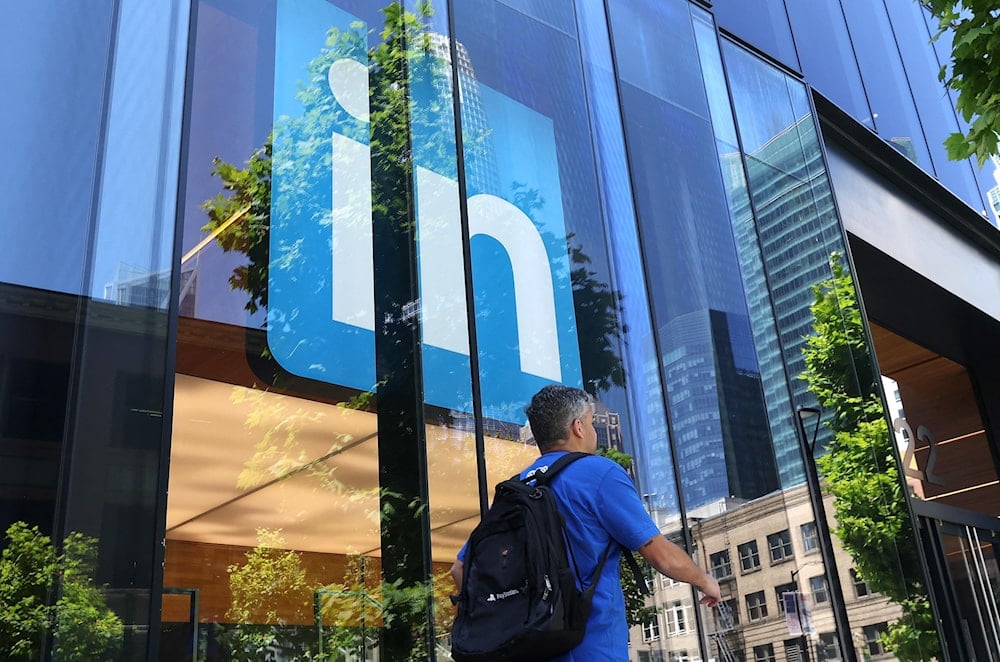Women say LinkedIn favors male-coded profiles in reach, visibility
Women experimenting with LinkedIn profiles say “bro-coded” language and male identities trigger algorithmic boosts in reach and engagement.
-

A pedestrian walks by a sign at a LinkedIn office on July 26, 2023, in San Francisco, California (AFP)
A growing number of women using LinkedIn have reported a significant increase in profile views and content engagement after altering their gender markers or adapting their language to align with what they describe as “bro-coded” communication, a trend sparking concern over algorithm bias and gender bias on social media platforms.
This informal experiment emerged from a series of viral posts in which female users claimed that changing their gender setting to "male", or using assertive, action-heavy vocabulary, terms like "drive", "accelerate", and "transform", resulted in drastically improved visibility across the professional networking platform.
Among those reporting sharp increases was Simone Bonnett, a social media consultant based in Oxford, who changed her profile name to “Simon E” and her pronouns to “he/him.”
“The kind of stats that I’m seeing at the moment are a 1,600% increase in profile views, which is wild if you think about what social media views look like at the moment, and a 1,300% increase in impressions. Also wild reach stats,” Bonnett said.
Read more: Musk’s X slams French foreign interference probe as politically driven
Bro-coding and algorithm bias spark informal experiments
While LinkedIn claims its content visibility algorithm does not factor in demographic data, users who took part in the experiment said their findings suggest otherwise.
Megan Cornish, a communications strategist in the mental health tech sector, also modified her profile settings, changing her gender to male and using ChatGPT to reword her profile using what she described as "male-coded" language. The updated language emphasized agentic traits, using phrases such as "strategic leader" and "growth-driven innovator". She also applied this linguistic shift to older posts that had previously underperformed.
Cornish noted that the effect was almost immediate; her reach rose by 415% within a week, and a post about her experiment gained nearly 5,000 reactions. However, she ultimately abandoned the strategy, saying the tone no longer felt authentic.
“I was going to do it for a full month. But every day I did it, and things got better and better, I got madder and madder,” she said.
“Concise and clever, but also like warm and human. Now, bro-Megan was assertive and self-assured, like a white male swaggering around.”
Read more: Nine out of 10 people biased against women: UN report
Reactions mixed as women test LinkedIn’s engagement system
Not all participants reported the same results. Cass Cooper, a writer on technology and social media algorithms, said she changed her gender setting to "male" and her racial identity to "white". However, her reach declined, an outcome she said aligns with reports from other women of color who undertook similar changes.
“We know there’s algorithmic bias, but it’s really hard to know how it works in a particular case or why,” Cooper said. “I’m not frustrated with the platform. I’m more frustrated with the lack of progress [in society].”
While the outcomes varied, the anecdotal evidence of increased engagement under male-coded or altered identities has fueled broader questions about LinkedIn’s algorithm, the design of professional networking platforms, and embedded gender biases in AI-driven visibility systems.
Read more: Sexism against women increasing in France
LinkedIn denies gender bias, cites content volume surge
In a blog post published Thursday, LinkedIn acknowledged the circulating claims but denied any connection between demographic profile information and post performance. It stated that the platform’s ranking system relies on “hundreds of signals” but does not prioritize gender in determining reach.
“Changing gender on your profile does not affect how your content appears in search or feed,” a spokesperson said.
The company also attributed reduced reach for some users to a general uptick in content volume on the platform. It noted a 24% rise in comments and increased video uploads in the last quarter.
Platform’s shift reflects broader concerns about social media inequality
LinkedIn’s algorithm, like others used across major platforms, classifies posts based on content and what it calls a user’s “professional identity and skills.” The company says it evaluates its algorithms regularly and performs checks for gender-related disparities.
Still, creators have voiced frustration over what they see as the growing dominance of "bro-coding", a term used to describe assertive, jargon-heavy posts that often appear to be algorithmically favored.
“You always think of LinkedIn as being more genteel, more businesslike,” Bonnett said. “It’s not like that anymore. It’s starting to become the wild west.”

 5 Min Read
5 Min Read








